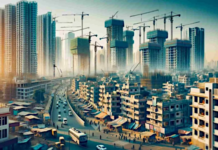Overall sales numbers have increased by 5.8% in 2016 over 2015 but still less than the 2014 numbers of 98,968 homes
Key Highlights of the report:
· Residential units being built in Pune has grown at a CAGR of 18.43% p.a. over the past 4 years
· Challenges on account of RERA leading to upward pressure on costs
· City wide average rates are down by 3.84% in 2016 on account of new inventory being launched at lower prices and smaller sizes.
· While the overall drop in prices is 3.18% for the Pune market over 24 months, some micro markets have bucked the trend and shown increases from 4% to 15%
· PMRDA has seen a huge increase in its market share to 53.42% while the PMC area has decreased to 24.10% over the past 24 months
· Premium plus and luxury segment sees the biggest reduction in new flats launched in 2016 as compared to 2015 – a reduction of 37% and 48% respectively
Pune, January 11, 2017: Gera Developments, pioneers of the real estate business and the award winning creators of premium residential and commercial projects in Pune and Goa, today presented the Gera Pune Residential Realty Report for the period July – December 2016. The report indicates that, although the overall real estate market is facing headwinds on account of several macro-economic dynamics at play but below the surface the Pune realty sector is looking positive. Residential units being built in Pune has grown at a CAGR of 18.43% p.a. over the past 4 years from 1,65,650 units in Dec’12 to 3,25,843 units in Dec’16 thus indicating that Pune market has nearly doubled in terms of inventory over the last 4 years. From 1813 projects being built in Dec’12, the number is now at twofold that size with 3630 projects in Dec’16.
Over the same 4 year period unsold stock has grown at a CAGR of 26.09% p.a. from 41,329 units in Dec’12 to 1,04,452 units in Dec’16 indicating that demand has lagged behind this rapid expansion in inventory. The outcome of this is visible in the percentage of inventory available for sale that has risen from 25% available for sale in December 2012 to 32% available for sale in December 2016. There has been 21% reduction in the new units being launched in 2016 compared to 2015. On an overall basis stock available for sale has decreased from 1,04,565 units in Dec’15 to 1,04,452 units in Dec’16. The maximum reduction of the stock available for sale is seen in the budget segment where it has dropped by 4.23% from 43,396 units available in Dec’15 to 41,560 units available in Dec’16. The other segment where inventory available for sale has reduced is the Value segment (a drop of 1.4% from 24,029 units in Dec’15 to 23,695 units in Dec’16). In the Luxury segment inventory for sale has gone up sharply by 23.2% (from 4121 units in Dec ’15 to 5079 units in Dec’16). Clearly, the market momentum is in the Budget and Value segments. There has been an increase in the overall annual sales across all segments except for the Luxury segment which saw a near 18% drop in annual sales.
Mr. Rohit Gera, Managing Director, Gera Developments while sharing his perspective on the report said, “On analyzing the inventory available for sale based on the construction stage of the project, the inventory available for sale in the “Early” and “End” stages has seen the maximum reduction. Stock for sale in the “Early” stage has dropped by 13.2% from 45,078 in Dec’15 to 39120 in Dec’16 while the drop in stock for sale is even more pronounced at 30.1% in the “End” stage projects from 5648 units in Dec’15 to 3947 units in Dec’16. Flat purchases are taking place in projects that are just launched (probably on account of size and budget) and those closer to possession where there is a visibility in possession and completion dates. The actual sales numbers indicate overall sales volume has gone up by 5.83% over 2015.”
2016 has been an extremely eventful year for the real estate industry in India. The year saw what was probably the highest and most aggressive intervention by the courts against errant developers, the passing of the Real Estate Regulatory Act (RERA) in May 2016 followed by the demonetization in November 2016 have all shaken up the sector. In general there has been expectation and hope to see prices correct sharply. This is without factoring in the fact that 3 years of virtual stagnancy in prices has already effectively translated into a substantial price drop in real terms.
In this overall scenario, the impact of the slowdown in Pune’s real estate market is finally visible in the numbers. Average rates across the city are down 3.84% in 2016 as compared to the citywide average rates in 2015. This is due to an increase in new flats at lower prices rather than a reduction of prices of existing projects. The average price in June 2016 was Rs. 4993 per sf and the same projects in December 2016 were priced at Rs. 4988 per sf. There is no significant correction in absolute terms. Over the period July 2016 to December 2016, the average rates across the city continue to drop. The second half of 2016 saw average prices dropping by 1.7% on the back of a 2.2% drop in the first half of 2016. This indicates that the overall market has seen virtually no appreciation over the last 2.5 years. When considering inflation, this means there is actually a price correction of approx. 18% in real terms over the past 30 months.
Mr. Gera commenting on the pricing trend said, “The 12 month’s average price change has shown a steep drop compared to the trend over the past 4 years. 2013 saw prices rise 14.08%. This reduced to 5.38% in 2014. The increase fell to a negligible 0.76% in 2015 and for the 12 months ending December 2016 average prices have reduced 3.84%. It is interesting to note that while the overall drop in prices is 3.18% for the Pune market over 24 months there are micro markets that have bucked the trend and have in fact shown increases from 4% to 15%. The sentiment regarding price drop has driven potential home buyers to adopt a wait and watch approach in the hope of a dramatic price correction. At the same time, the impact of an increase in cost for developers on various counts as a result of the RERA is exerting an upward pressure on price. The silver lining however, is the fact that overall sales numbers for the year have moved up from 88,815 units in 2015 to 93,995 units in 2016 which is an increase of 5.8%. However, the sales are still not at the 2014 numbers of 98,968 homes.”
Another interesting highlight Mr. Gera pointed out “The city of Pune historically was confined to the limits of the Pune Municipal Corporation. This has substantially changed with the large part of the development now having moved into the PMRDA areas. The market share of the PMRDA in unit terms has risen to over 53%. PCMC has retained its share at approx. 21% while PMC area saw a contraction in the market share from 29.58% down to 24.10% over the past 24 months.”
Developers have been responsive to the market conditions and average size of the unsold inventory has steadily reduced from 1032 sf in December 2014 to 980 sf in December 2015 and down to 956 sf in December 2016. The year gone by also saw a reduction of 21% in the total number of flats launched. The city saw 0.94 lakh homes in 2016 down from 1.19 lakh homes launched in 2015. The gross value of the unsold inventory stands at Rs. 53,181 crores on Dec’16 as against the gross value of Rs 55,323 crores as on Dec’15, a reduction of 3.87%. This is on account of the reduction in overall unsold stock and prices over the same period.
With the available inventory at lower price points as well as smaller sizes, Pune is a market where residential real estate is amongst the most affordable in the country given that it also ranks amongst the most livable cities in India. The number of projects being built has doubled in the last 4 years and a number of micro-markets that were previously far off have come into the mainstream urban agglomeration. The demand for residential properties remains healthy as witnessed in the growth of sales volume that has taken place over the previous year and over time demand is going to migrate to these areas some of which are in the sub Rs. 4000 psf segment.
The negative sentiment surrounding real estate is reflected in the supply side through the drop in the number of fresh units being launched and the drop in prices of new inventory. However, from the demand side sales volume is up and the unsold stock is down. How the inventory, price and sales relationship pans out especially in light of reducing inventory, reducing interest rates and increasing input costs for developers remains to be seen.
In addition, the transparency and declaration of various details, presence of a regulator to protect the customer will reduce the ability of unscrupulous fly by night operators. The need for approvals up front before selling apartments will require greater capital from developers. This is further coupled with restrictions on withdrawing of inflows from customers that is required to be parked in escrow accounts. All this aspects will further reduce the quantum of supply in the market in the short run.
The downward trend in interest rates is already leading to increased affordability amongst home buyers. The combination of increased demand on account of increased affordability, 3 years of real price reductions, contracting supply and increasing cost of development all point to rates moving upward. What is crystal clear is that the markets are clearly in unchartered territory and a large number of developers will need to change their business models in order to stay relevant in 2017 and beyond.
Corporate Comm India(CCI Newswire)




















